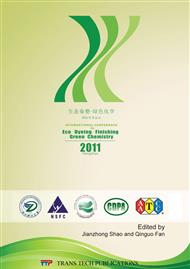p.1
p.5
p.10
p.16
p.23
p.28
p.33
p.44
Effects of Solvents on the Electrical Resistance of Poly(3,4-ethylenedioxythiophene) on Textiles
Abstract:
The chemical resistance of Poly-3,4-ethylenedioxythiophene (PEDOT) was tested in both organic and inorganic solvents including Chloroform, DMSO, Xylene, THF, sulfuric acid, sodium hydroxide and sodium chloride. PEDOT was synthesized via the vapor-phase polymerization and coated on PET/cotton, cotton and polyester textile substrates. Electrical resistances of the PEDOT were measured both before and after chemical treatments. The morphological changes after treatments were studied by scanning electron microscope (SEM). The PEDOT coated fabrics demonstrated excellent chemical-resistant property since its electrical resistance maintained on the order of magnitude of 100 ohm after treatment in almost all the solvents except NaOH with which a remarkable increasing of electrical resistance occurred due to disappearing PEDOT from the substrate indicating its potential to be a good solvent for PEDOT.
Info:
Periodical:
Pages:
16-22
Citation:
Online since:
January 2012
Authors:
Keywords:
Price:
Сopyright:
© 2012 Trans Tech Publications Ltd. All Rights Reserved
Share:
Citation:


